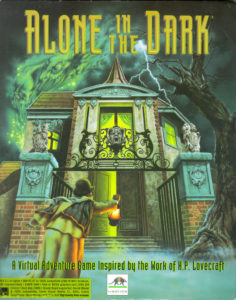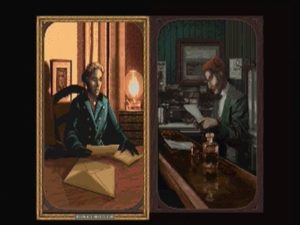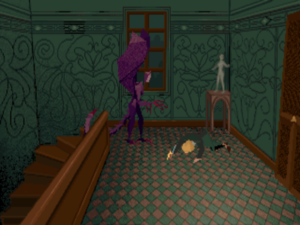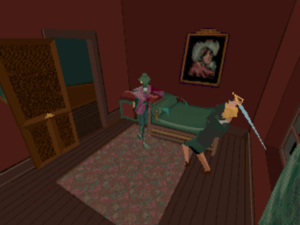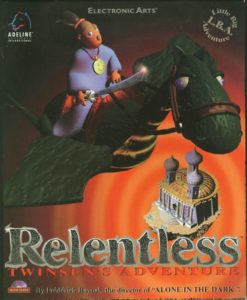Most videogame stories are power fantasies. You spend your time getting ever stronger, ever tougher, ever more formidable as you accumulate experience points, gold, and equipment. Obstacles aren’t things to go around; they’re things you go through. If you can’t get past any given monster, the solution is to go kill some other monsters, then come back when you’re yet more powerful and slay the big beast at last. Life, these games tell us, is or ought to be one unadulterated ride up the escalator of success; a setback just means you haven’t yet risen high enough.
That dynamic held true in 1992 just as much as it usually does today. But during that year there came a well-nigh revolutionary game out of France that upended all of these traditional notions about what the medium of videogames can do and be. It cast you as a painfully ordinary, near-powerless individual adrift in a scary world, with no surefire panaceas in the form of experience points, gold, or portable rocket launchers to look forward to. It was just you and your wits, trapped in a haunted house full of creatures that were stronger than you and badly wanted to kill you. Despite its supernatural elements, this game’s scenario felt more disconcertingly close to real life than that of any of those other games. Here, you truly were alone in the dark. Aren’t we all from time to time?
Any story of how this shockingly innovative game came to be must begin with that of Frédérick Raynal, its mastermind. Born in the south-central French town of Brive-la-Gaillarde in 1966, Raynal was part of the first generation of European youths to have access to personal computers. In fact, right from the time his father first came home with a Sinclair ZX81, he was obsessed with them. He was also lucky: in a dream scenario for any budding hacker, his almost equally obsessed father soon added computers to the product line of the little videocassette-rental shop he owned, thus giving his son access to a wide variety of hardware. Raynal worked at the store during the day, renting out movies and watching them to kill the time — he was a particular fan of horror movies, a fact which would soon have a direct impact on his career — and helping customers with their computer problems. Then, with a nerdy young man’s total obliviousness to proportion, he hacked away most of the night on one or another of the machines he brought home with him. He programmed his very first released game, a platformer called Robix, in 1986 on an obscure home-grown French computer called the Exelvision which his father sold at the store. His father agreed to sell his son’s Exelvision game there as well, managing to shift about 80 units to customers desperate for software for the short-lived machine.
Raynal’s lifestyle was becoming so unbalanced that his family was beginning to worry about him. One day, he ran out of his room in a panic, telling them that all of the color had bled out of his vision. His mother bustled him off to an ophthalmologist, who told him he appeared to have disrupted the photoreceptors in his eyes by staring so long at a monitor screen. Thankfully, the condition persisted only a few hours. But then there came a day when he suddenly couldn’t understand anything that was said to him; he had apparently become so attuned to the language of computer code that he could no longer communicate with humans. That worrisome condition lasted several weeks.
Thus just about everyone around him took it as a good thing on the whole when he was called up for military service in 1988. Just before leaving, Raynal released his second game, this time for MS-DOS machines. Not knowing what else to do with it, he simply posted it online for free. Popcorn was a Breakout clone with many added bells and whistles, the latest entry in a sub-genre which was enjoying new popularity following the recent success of the Taito arcade game Arkanoid and its many ports to home computers and consoles. Raynal’s game could hold its head high in a crowded field, especially given its non-existent price tag. One magazine pronounced it one of the five best arcade games available for MS-DOS, whether commercial or free, and awarded it 21 points on a scale of 20.
Raynal was soon receiving letters at his military posting from all over the world. “Popcorn has made my life hell!” complained one player good-naturedly. Another wrote that “I caught acute Popcornitus. And, it being contagious, now my wife has it as well.” When Raynal completed his service in the summer of 1989, his reputation as the creator of Popcorn preceded him. Most of the companies in the French games industry were eager to offer him a job. His days working at his father’s computer store, it seemed, were behind him. The Lyon-based Infogrames, the most prominent French publisher of all, won the Raynal sweepstakes largely by virtue of its proximity to his hometown.
Yet Raynal quickly realized that the company he had elected to join was in a rather perilous state. An ambitious expansion into many European markets hadn’t paid off; in fact, it had very nearly bankrupted them. Bruno Bonnell, Infogrames’s co-founder and current chief executive, had almost sold the company to the American publisher Epyx, but that deal had fallen through as soon as the latter had gotten their first good look at the state of his books. It seemed that Infogrames would have to dig themselves out of the hole they’d made. Thus Bonnell had slashed costs and shed subsidiaries ruthlessly just to stay alive. Now, having staunched the worst of the bleeding, he knew that he needed as many talented programmers as he could get in order to rebuild his company — especially programmers like Raynal, who weren’t terribly assertive and were naive enough to work cheap. So, Raynal was hired as a programmer of ports, an unglamorous job but an absolutely essential one in a European market that had not yet consolidated around a single computer platform.
Bonnell, for his part, was the polar opposite of the shy computer obsessive he had just hired; he had a huge personality which put its stamp on every aspect of life at Infogrames. He believed his creativity to be the equal of anyone who worked for him, and wasn’t shy about tossing his staff ideas for games. He called one of them, which he first proposed when Raynal had been on the job for about a year, In the Dark. A typically high-concept French idea, its title was meant to be taken literally. The player would wander through a pitch-dark environment, striking the occasional match from her limited supply, but otherwise relying entirely on sound cues for navigation. Bonnell and Raynal were far from bosom buddies, then or ever, but this idea struck a chord with the young programmer.
As Raynal saw it, the question that would make or break the idea was that of how to represent a contiguous environment with enough verisimilitude to give the player an embodied sense of really being there in the dark. Clearly, a conventional adventure-game presentation, with its pixel graphics and static views, wouldn’t do. Only one approach could get the job done: 3D polygonal graphics. Not coincidentally, 3D was much on Raynal’s mind when he took up Bonnell’s idea; he’d been spending his days of late porting an abstract 3D puzzle game known as Continuum from the Atari ST to MS-DOS.
I’ve had occasion to discuss the advantages and disadvantages of this burgeoning new approach to game-making in previous articles, so I won’t rehash that material here. Suffice to say that the interest so many European programmers had in 3D reflected not least a disparity in the computing resources available to them in comparison to their American counterparts. American companies in this period were employing larger and larger teams, who were filling handfuls of floppy disks — and soon CD-ROMs — with beautiful hand-drawn art and even digitized snippets of real-world video. European companies had nothing like the resources to compete with the Americans on those terms. But procedurally-generated 3D graphics offered a viable alternative. At this stage in the evolution of computer technology, they couldn’t possibly be as impressively photorealistic as hand-drawn pixel art or full-motion video, but they could offer far more flexible, interactive, immersive environments, with — especially when paired with a French eye for aesthetics — a certain more abstracted allure of their own.
This, then, was the road Raynal now started down. It was a tall order for a single programmer. Not only was he trying to create a functional 3D engine from scratch, but the realities of the European market demanded that he make it run on an 80286-class machine, hardware the Americans by now saw as outdated. Even Bonnell seemed to have no confidence in Raynal’s ability to bring his brainstorm to fruition. He allowed Raynal to work on it only on nights and weekends, demanding that he spend his days porting SimCity to the Commodore CDTV.
An artist named Didier Chanfray was the closest thing to a partner and confidante which Raynal had at Infogrames during his first year of working on the engine. It was Chanfray who provided the rudimentary graphics used to test it. And it was also Chanfray who, in September of 1991, saw the full engine in action for the first time. A character roamed freely around a room under the control of Raynal, able to turn about and bend his body and limbs at least semi-realistically. The scene could be viewed from several angles, and it could be lit — or not — by whatever light sources Raynal elected to place in the room. Even shadows appeared; that of the character rippled eerily over the furniture in the room as he moved from place to place. Chanfray had never seen anything like it. He fairly danced around Raynal’s desk, pronouncing it a miracle, magic, alchemy.
In the meantime, Bruno Bonnell had negotiated and signed a new licensing deal — not exactly a blockbuster, but something commensurate with a rebuilding Infogrames’s circumstances.
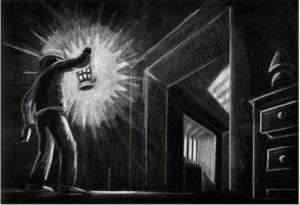
Something tentacled and other-worldly, it seems, got into the water at Infogrames from the start: Didier Chanfray provided this very Lovecraftian concept drawing for Raynal’s game long before the conscious decision was made to turn it a Lovecraft pastiche. Raynal kept the sketch tacked on the wall beside his desk throughout the project as a reminder of the atmosphere he was going for.
The American horror writer H.P. Lovecraft, who died well before the advent of the computer age in 1937, was nowhere near as well-known in 1991 as he is today, but his so-called “Cthulhu Mythos” of extra-dimensional alien beings, terrifying by virtue of their sheer indifference to humanity and its petty morality, had already made appearances in games. The very first work of ludic Lovecraftia would appear to be the 1979 computer game Kadath, an odd sort of parser-less text adventure. Two years later, at the height of the American tabletop-RPG craze, a small company called Chaosium published Call of Cthulhu, a game which subverted the power fantasy of tabletop Dungeons & Dragons in much the same way that Raynal’s project would soon be subverting that of so many computer games. Still, although Call of Cthulhu was well-supported by Chaosium and remained reasonably popular by the standards of its niche industry throughout the 1980s and beyond, its success didn’t lead to any Lovecraftian onslaught in the realm of digital games. The most notable early example of the breed is Infocom’s very effective 1987 interactive fiction The Lurking Horror. But, being all text at a time when text adventures were becoming hard sells, it didn’t make much commercial impact.
Now, though, Bonnell believed the time had come for a more up-to-date Lovecraftian computer game; he believed such a thing could do well, both in France and elsewhere.
Lovecraft had long had a strong following in France. From the moment his books were first translated into the language in 1954, they had sold in considerable numbers. Indeed, in 1991 H.P. Lovecraft was about as popular in France as he was anywhere — arguably more popular on a per-capita basis than in his native land. The game of Call of Cthulhu too had long since been translated into French, giving a potential digital implementation of it as much natural appeal there as in its homeland. So, Bonnell approached Chaosium about licensing their Call of Cthulhu rules for computers, and the American company agreed.
When viewed retrospectively, it seems a confusing deal to have made, one that really wasn’t necessary for what Infogrames would ultimately choose to do with Lovecraft. When Lovecraft died in obscurity and poverty, he left his literary estate in such a shambles that no one has ever definitively sorted out its confusing tangle of copyright claimants; his writing has been for all intents and purposes in the public domain ever since his death, despite numerous parties making claims to the contrary. Prior to publishing their Lovecraft tabletop RPG, Chaosium had nevertheless negotiated a deal with Arkham House, the publisher that has long been the most strident of Lovecraft’s copyright claimants. With that deal secured, Chaosium had promptly trademarked certain catchphrases, including “Call of Cthulhu” itself, in the context of games. Yet as it turned out Infogrames would use none of them; nor would they draw any plots directly from any of Lovecraft’s published stories. Like the countless makers of Lovecraftian games and stories that would follow them, they would instead draw from the author’s spirit and style of horror, whilst including just a few of his more indelible props, such as the forbidden book of occult lore known as the Necronomicon.
The first Lovecraftian game Infogrames would make would, of course, be the very game that Frédérick Raynal had now spent the last year or so prototyping during his free time. By the time news of his work reached Bonnell, most of Infogrames’s staff were already talking about it like the second coming. While the idea that had inspired it had been wonderfully innovative, it seemed absurd even to the original source of said idea to devote the best 3D engine anyone had ever seen to a game that literally wouldn’t let you see what it could do most of the time. It made perfect sense, on the other hand, to apply its creepy visual aesthetic to the Lovecraft license. The sense of dread and near-powerlessness that was so consciously designed into the tabletop RPG seemed a natural space for the computer game as well to occupy. It was true that it would have to be Call of Cthulhu in concept only: the kinetic, embodied, real-time engine Raynal had created wasn’t suitable for the turn-based rules of the tabletop RPG. For that matter, Raynal didn’t even like the Chaosium game all that much; he considered it too complicated to be fun.
Still, Bonnell, who couldn’t fail to recognize the potential of Raynal’s project, put whatever resources he could spare from his still-rebuilding company at the mild-mannered programmer’s disposal: four more artists to join Chanfray, a sound designer, a second programmer and project manager. When the team’s first attempts at writing an authentic-feeling Lovecraftian scenario proved hopelessly inadequate, Bonnell hired for the task Hubert Chardot, a screenwriter from 20th Century Fox’s French division, a fellow who loved Lovecraft so much that he had turned his first trip to the United States into a tour of his dead hero’s New England haunts. One of Chardot’s first suggestions was to add the word “alone” to the title of the game. He pointed out, correctly, that it would convey the sense of existential loneliness that was such an integral part of Lovecraftian horror — even, one might say, the very thing that sets it apart from more conventional takes on horror.
The game takes place in the 1920s, the era of Lovecraft himself and of most of his stories (and thus the default era as well for Chaosium’s Call of Cthulhu game). It begins as you arrive in the deserted Louisiana mansion known as Derceto, whose owner Jeremy Hartwood has recently hanged himself. You play either as Edward Carnby, a relic hunter on the trail of a valuable piano owned by the deceased, or as Emily Hartwood, the deceased’s niece, eager to clear up the strange rumors that have dogged her uncle’s reputation and to figure out what really went down on his final night of life. The direction in which the investigation leads you will surprise no one familiar with Lovecraft’s oeuvre or Chaosium’s RPG: occult practices, forbidden books, “things man was never meant to know,” etc. But, even as Chardot’s script treads over this ground that was well-worn already in the early 1990s, it does so with considerable flair, slowly revealing its horrifying backstory via the books and journals you find hidden about the mansion as you explore. (There is no in-game dialog and no real foreground story whatsoever, only monsters and traps to defeat or avoid.) Like most ludic adaptations of Lovecraft, the game differs markedly from its source material only in that there is a victory state; the protagonist isn’t absolutely guaranteed to die or become a gibbering lunatic at the end.
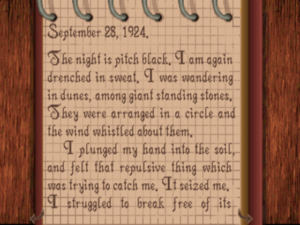
One of the in-game journals, which nails the spirit and style of Lovecraft perfectly. As I noted in an earlier article about the writer, the emotion he does better than any other is disgust.
Yet Chaosium wasn’t at all pleased when Infogrames sent them an early build of the game for their stamp of approval. It seems that the American company had believed they were licensing not just their trademarks to their French colleagues, nor even the idea of a Lovecraft game in the abstract, but rather the actual Call of Cthulhu rules, which they had expected to see faithfully implemented. And, indeed, this may have been Bonnell’s intention when he was making the deal — until Raynal’s 3D engine had changed everything. Chaosium, who had evidently been looking forward to an equivalent of sorts to the Gold Box line of licensed Dungeons & Dragons CRPGs, felt betrayed. After some tense negotiation, they agreed to let Alone in the Dark continue without the Call of Cthulhu name on the box; some editions would include a note saying the game had been “inspired by the works of H.P. Lovecraft,” while others wouldn’t even go that far. In return for Chaosium’s largess on this front, Infogrames agreed to make a more conventional adventure game that would make explicit use of the Call of Cthulhu trademarks.
Call of Cthulhu: Shadow of the Comet, the fruit of that negotiation, would prove a serviceable game, albeit one that still didn’t make much direct use of the tabletop rules. But, whatever its merits, it would come and go without leaving much of a mark on an industry filled to bursting with graphical adventures much like it in terms of implementation. Alone in the Dark, on the other hand, would soon be taking the world by storm — and Chaosium could have had their name on it, a form of advertisement which could hardly have failed to increase their commercial profile dramatically. Chalk it up as just one more poor decision in the life of a company that had a strange talent for surviving — Chaosium is still around to this day — without ever quite managing to become really successful.
Infogrames got their first preview of just what an impact Alone in the Dark was poised to make in the spring of 1992, when Dany Boolauk, a journalist from the French videogame magazine Tilt, arrived to write a rather typical industry puff piece, a set of capsule previews of some of the company’s current works-in-progress. He never got any further than Alone in the Dark. After just a few minutes with it, he declared it “the best game of the last five years!” and asked for permission to turn the capsule blurb about it into a feature-length article, complete with a fawning interview with Raynal. (He described him in thoroughly overwrought terms: as a reincarnation of The Little Prince from Antoine de Saint-Exupéry’s beloved novella of the same name.) In a “review” published in the summer of 1992, still a couple of months before Infogrames anticipated releasing the game, he gave it 19 of 20 stars, gushing over its “exceptional staging” and “almost perfect character movement,” calling it “a revolution in the field of play” that “people must buy!”
Bruno Bonnell was pleased with the positive press coverage, but less thrilled by Boolauk’s portrayal of Raynal as the game’s genius auteur. He called in his introverted young programmer, who seemed a bit befuddled by all the attention, and told him to scrub the words “a Frédérick Raynal creation” from the end credits. Alone in the Dark, he said, was an Infogrames creation, full stop. Raynal agreed, but a grievance began to fester in his heart.
Thanks to Bonnell’s policy of not advertising the individuals behind Infogrames’s games, Raynal’s name didn’t spread quite so far and wide as that of such other celebrated gaming auteurs as Éric Chahi, the mastermind of Another World, France’s standout game from the previous year. Nevertheless, upon its European release in September of 1992, Raynal’s game stood out on its own terms as something special — as an artistic creation that was not just fun or scary but important to its medium. As one would expect, the buzz started in France. “We review many games,” wrote one magazine there. “Some are terrible, some mediocre, some excellent. And occasionally there comes along the game that will revolutionize the world of microcomputers, one that causes sleepless nights, one that you cannot tear yourself away from, can only marvel at. We bid welcome now to the latest member of this exclusive club: Alone in the Dark.” By the end of 1992, the game was a hit not only in France but across most of Europe. Now for America.
Bonnell closed a deal with the American publisher Interplay for distribution of the game there. Interplay had also published Another World, which had turned into a big success Stateside, and the company’s head Brian Fargo was sure he saw similar potential in Alone in the Dark. He thus put the game through his company’s internal testing wringer, just as he had Another World; the French studios had their strengths, but such detail work didn’t tend to be among them. Raynal’s game became a much cleaner, much more polished experience thanks to Interplay’s QA team. Yet Bonnell still had big international ambitions for Infogrames, and he wasn’t willing to let such a remarkable game as this one share with Another World the fate of becoming known to American players simply as an Interplay title. Instead he convinced Fargo to accept a unique arrangement. Interplay and Infogrames each took a stake in a new shared American subsidiary known as I-Magic, under which imprint they published Alone in the Dark.
The game took North America by storm in early 1993, just as it had Europe a few months earlier. It was that rarest of things in games, a genuine paradigm shift; no one had ever seen one that played quite like this. Worldwide, it sold at least 400,000 copies, putting Infogrames on the map in the United States and other non-European countries in the process. Indeed, amidst the international avalanche of praise and punditry, perhaps the most gratifying press notice of all reached Frédérick Raynal’s ears from all the way off in Japan. Shigeru Miyamoto, the designer of Super Mario Bros. and many other iconic Nintendo classics, proclaimed Alone in the Dark to be, more so than any other game, the one he wished he could have come up with.
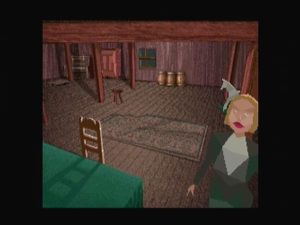
Arguably the creepiest visual in the game is the weird mannequin’s head of your own character. Its crudely painted expression rather smacks of Chucky the doll from the Child’s Play horror films.
Seen from the perspective of a modern player, however, the verdict on Alone in the Dark must be more mixed. Some historically important games transcend that status to remain vital experiences even today, still every bit as fun and playable as the day they were made. But others — and please forgive me the hoary old reviewer’s cliché! — haven’t aged as well. This game, alas, belongs to the latter category.
Today, in an era when 3D graphics have long since ceased to impress us simply for existing at all, those of Alone in the Dark are pretty painful to look at, all jagged pixels sticking out everywhere from grotesquely octagonal creatures. Textures simply don’t exist, leaving everything to be rendered out of broad swatches of single colors. And the engine isn’t even holistically 3D: the 3D characters move across pasted-on pre-rendered backgrounds, which looks decidedly awkward in many situations. (On the other hand, it could have been worse: Raynal first tried to build the backgrounds out of digitized photographs of a real spooky mansion, a truly unholy union that he finally had to give up on.) Needless to say, a comparison with the lovingly hand-drawn pixel art in the adventure games being put out by companies like LucasArts and Sierra during this period does the crude graphics found here no favors whatsoever. Some of the visuals verge on the unintentionally comical; one of the first monsters you meet was evidently meant to be a fierce dragon-like creature, but actually looks more like a sort of carnivorous chicken. (Shades of the dragon ducks from the original Atari Adventure…)
Then, too, the keyboard-only controls are clunky and unintuitive, and they aren’t made any less awkward by a fixed camera that’s constantly shifting about to new arbitrary locations as you move through the environment; some individual rooms have as many as nine separate camera angles. This is confusing as all get-out when you’re just trying to get a sense of the space, and quickly becomes infuriating when you’re being chased by a monster and really, really don’t have time to stop and adjust your thinking to a new perspective.
The more abstract design choices also leave something to be desired. Sudden deaths abound. The very first room of the game kills you when you step on a certain floorboard, and every book is either a source of backstory and clues or an instant game-ender; the only way to know which it is is to save your game and open it. Some of the puzzles are clever, some less so, but even those that are otherwise worthy too often depend on you standing in just the right position; if you aren’t, you get no feedback whatsoever on what you’re doing wrong, and are thus likely to go off on some other track entirely, never realizing how close you were to the solution. This fiddliness and lack of attention to the else in the “if, then, else” dynamic of puzzle design is a clear sign of a game that never got sufficiently tested for playability and solubility. At times, the game’s uncommunicativeness verges on the passive-aggressive. You’ll quickly grow to loathe the weirdly stilted message, “There is a mechanism which can be triggered here,” which the game is constantly spitting out at you as you gaze upon the latest pixelated whatsit. Is it a button? A knob? A keyhole? Who knows… in the end, the only viable course of action is to try every object in your inventory on it, then go back and start trying all the other objects you had to leave lying around the house thanks to your character’s rather brutal inventory limit.
Yes, one might be able to write some of the game’s issues off as an aesthetic choice — as merely more ways to make the environment feel unsettling. Franck de Girolami, the second programmer on the development team as well as its project leader, has acknowledged using the disorienting camera consciously for just that purpose: “We realized that the camera angles in which the player was the most helpless were the best to bring in a monster. Players would instantly run for a view in which they felt comfortable.” While one does have to admire the team’s absolute commitment to the core concept of the game, the line between aesthetic choice and poor implementation is, at best, blurred in cases like this one.
And yet the fact remains that it was almost entirely thanks to that same commitment to its core concept that Alone in the Dark became one of the most important games of its era. Not a patch on a contemporary like Ultima Underworld as a demonstration of the full power and flexibility of 3D graphics — to be fair, it ran on an 80286 processor with just 640 K of memory while its texture-mapped, fully 3D rival demanded at least an 80386 with 2 MB — it remained conceptually unlike anything that had come before in daring to cast you as an ordinary mortal, weak and scared and alone, for whom any aspirations toward glory quickly turn into nothing more than a desperate desire to just escape the mansion. For all that it threw the Call of Cthulhu rules completely overboard, it retained this most fundamental aspect of its inspiration, bringing Chaosium’s greatest innovation to a digital medium for the first time. It’s not always impossible to kill the monsters in Alone in the Dark — often it’s even necessary to do so — but, with weapons and ammunition scarce and your health bar all too short, doing so never fails to feel like the literal death struggle it ought to. When you do win a fight, you feel more relieved than triumphant. And you’re always left with that nagging doubt in the back of the mind as you count your depleted ammo and drag your battered self toward the next room: was it worth it?
The legacy of this brave and important game is as rich as that of any that was released in its year, running along at least three separate tracks. We’ll begin with the subsequent career of Frédérick Raynal, its original mastermind.
The seeds of that career were actually planted a couple of weeks before the release of Alone in the Dark, when Raynal and others from Infogrames brought a late build of it to the European Computer Trade Show in London. There he met the journalist Dany Boolauk once again, learning in the process that Boolauk had switched gigs: he had left his magazine and now worked for Delphine Software, one of Infogrames’s French competitors. Delphine had recently lost the services of their biggest star: Éric Chahi, the auteur behind the international hit Another World. As his first assignment in his own new job, Boolauk had been given the task of replacing Chahi with a similarly towering talent. Raynal struck him as the perfect choice; he rather resembled Chahi in many respects, what with his very French aesthetic sensibility, his undeniable technical gifts, and his obsessive commitment to his work. Boolauk called in Paul de Senneville, the well-known composer who had launched Delphine Software as a spinoff from his record label of the same name, to add his dulcet voice to the mix. “We wish to place you in a setting where you will be able to create, where you will not be bullied, where we can make you a star,” said the distinguished older gentleman. “We want to give free rein to the fabulous talent you showed in Alone in the Dark.” When Raynal returned to Lyon to a reprimand from Bruno Bonnell for letting his game’s planned release date slip by a week, the contrast between his old boss and the possible new one who was courting him was painted all too clearly.
Much to Raynal’s dismay, Bonnell was already pushing him and the rest of the team that had made the first Alone in the Dark to make a sequel as quickly as possible using the exact same engine. One Friday just before the new year, Bonnell threw his charges a party to celebrate what he now believed would go down in history as the year when his struggling company turned the corner, thanks not least to Raynal’s game. On the following Monday morning, Raynal knocked on Bonnell’s office door along with three other members of the newly christened Alone in the Dark 2 team, including his most longstanding partner Didier Chanfray. They were all quitting, going to work for Delphine, Raynal said quietly. Much to their surprise, Bonnell offered to match Delphine’s offer, the first overt sign he’d ever given that he understood how talented and valuable they really were. But his counteroffer only prompted Delphine to raise the stakes again. Just after New Years Day, Bonnell bowed out of the bidding in a huff: “You want to leave? Goodbye!”
A couple of weeks later, the videogame magazine Génération 4 held an awards ceremony for the previous year’s top titles at Disneyland Paris. Everyone who had been involved with Alone in the Dark, both those who still worked at Infogrames and those who didn’t, was invited. When, as expected, it took the prize for top adventure game, Bruno Bonnell walked onto the stage to accept the award on behalf of his company. The departure of Raynal and crew being the talk of the industry, the room held its collective breath to see what would happen next. “My name is Bruno Bonnell,” he said from behind the rostrum. “I’d like to thank God, my dog, my grandmother, and of course the whole team at Infogrames for a beautiful project.” And with that he stumped offstage again.
It hadn’t been a particularly gracious acceptance speech, but Raynal and his colleagues nonetheless had much to feel good about. Dany Boolauk and Paul de Senneville were true to their word: they set Raynal up with a little auteur’s studio all his own, known as Adeline Software. They even allowed him to run it from Lyon rather than joining the rest of Delphine in Paris.
Naturally, all of the Alone in the Dark technology, along with the name itself and the Chaosium license (whatever that was worth), stayed with Infogrames. Raynal and his colleagues were thus forced to develop a new engine in the style of the old and to devise a fresh game idea for it to execute. Instead of going dark again, they went light. Released in 1994, Little Big Adventure (known as Relentless: Twinsen’s Adventure in North America) was a poetic action-adventure set in a world of cartoon Impressionism, consciously conceived by Raynal as an antidote to the ultra-violent Doom mania that was sweeping the culture of gaming at the time. He followed it up in 1997 with Little Big Adventure 2 (known as Twinsen’s Odyssey in North America). Although both games were and remain lovely to look at, Raynal still struggled to find the right balance between the art and the science of game design; both games are as absurdly punishing to play as they are charming to watch, with a paucity of save points between the countless places where they demand pin-point maneuvering and split-second timing. This sort of thing was, alas, something of a theme with the French games industry for far too many years.
This, then, is one legacy of Alone in the Dark. Another followed on even more directly, taking the form of the two sequels which Infogrames published in 1993 and 1994. Both used the same engine, as Bruno Bonnell had demanded in the name of efficiency, and both continued the story of the first game, with Edward Carnby still in the role of protagonist. (Poor Emily Hartwood got tossed by the wayside.) But, although Hubert Chardot once again provided their scripts, much of the spirit of the first game got lost, as the development team began letting the player get away with much more head-to-head combat. Neither sequel garnered as many positive reviews or sales as the original game, and Infogrames left the property alone for quite some time thereafter. A few post-millennial attempts to revive the old magic, still without the involvement of Raynal, have likewise yielded mixed results at best.
But it’s with Alone in the Dark‘s third legacy, its most important by far, that we should close. For several years, few games — not even its own sequels — did much to build upon the nerve-wracking style of play it had pioneered. But then, in 1996, the Japanese company Capcom published a zombie nightmare known as Resident Evil for the Sony Playstation console. “When I first played Resident Evil,” remembers Infogrames programmer Franck de Girolami, “I honestly thought it was plagiarism. I could recognize entire rooms from Alone in the Dark.” Nevertheless, Resident Evil sold in huge numbers on the consoles, reaching a mass market the likes of which Alone in the Dark, being available only on computers and the 3DO multimedia appliance, could never have dreamed. In doing so, it well and truly cemented the new genre that became known as survival-horror, which had gradually filtered its way up from the obscure works of a poverty-stricken writer to a niche tabletop RPG to a very successful computer game to a mainstream ludic blockbuster. Culture does move in mysterious ways sometimes, doesn’t it?
(Sources: the books La Saga des Jeux Vidéo by Daniel Ichbiah, Designers & Dragons: A History of the Roleplaying Game Industry, Volume 1 by Shannon Appelcline, and Alone in the Dark: The Official Strategy Guide by Johan Robson; Todd David Spaulding’s PhD thesis “H.P. Lovecraft & The French Connection: Translations, Pulps, and Literary History”; Computer Gaming World of February 1993; Amiga Format of June 1991; Edge of November 1994; Retro Gamer 98. Online sources include Adventure Europe‘s interview with Frédérick Raynal, Just Adventure‘s interview with Hubert Chardot, and the video of Frédérick Raynal’s Alone in the Dark postmortem at the 2012 Game Developers Conference.
The original Alone in the Dark trilogy is available as a package download at GOG.com.)

